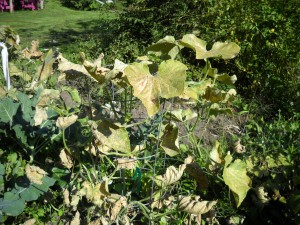Putting the Garden to Bed
Posted on Thursday, October 20, 2022 · Leave a Comment
Frost has already lightly brushed my garden, and hard frost is not far behind. Even in warmer spots it is good to start getting ready for winter. Let’s look at some of the key activities for all of us.
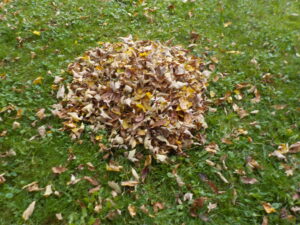
Save your fall leaves for use as mulch
First, remember to visit and support your local garden center. They want to unload as many plants now as they can – perennials, shrubs and trees. So they are discounting plants, often 25% or more. I recently got some big burr oaks at a 50% discount– a considerable saving. And it is not too late to plant.
I have read that woody plants store up food all summer when the sun is bright, and use some of it now to extend their roots out away from the main stem. So I like to plant trees in the fall especially since it is cooler and more rain is falling now than in mid-summer. Planting in spring and summer is good, too, since a tree has longer to get established before winter, and some gardeners insist that fall planting is risky. If you plant a tree, be sure to spread 2 inches of mulch around the tree to keep the roots warm as late into the fall as possible.
You may have already done so, but let me remind you anyhow to bring in your houseplants that have summered outside. Do it now, not after frost even for plants like rosemary that can sustain a temperature down to 25 degrees or so. Aphids are the biggest pest on houseplants. Outdoors they are eaten up by other insects or washed off by heavy rains, but indoors a plant that is already sulking is ripe for an infestation.
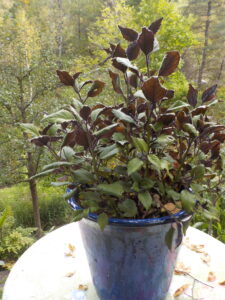
Wash houseplants with hose before bringing them inside to get rid of aphids
Use your hose to wash not only the tops of leaves, but the underside as well. And wash the surface of soil in the pot – do this by laying the plant on its side. This will help you to get rid of eggs and adult aphids, though a few elude me every year. Watch for aphids or their sticky droppings on leaves. If you see some, spray with Safer Soap to dehydrate the aphids and knock them dead. Repeat as necessary.
Your least favorite fall activity may be weeding and plant cleanup, though I kind of enjoy it. It is very important to remove rotten fruit, stems and leaves of tomatoes, potatoes, and vine crops as they often have mildew or fungus by now. Be sure to get them out of the garden ASAP. And if you have had bugs on any plants, put them in the household trash or on a burn pile. You don’t want them wintering over in the garden or the compost pile. You don’t have to wash tomato cages, their diseases won’t winter over on them.
Getting rid of weeds now is important, but so is covering the soil with leaves or mulch so those seeds blowing in the wind don’t land on bare earth and settle in, ready to grow in early spring – even before you have thought about planting next year’s veggies.
Fallen leaves are the best mulch available, and free. You can compact them and make them easier to move to the garden by running them over with the lawnmower. Or you can just rake them up and onto a tarp. They will settle in and not blow around if you do this just before a nice rain. But you can use grass clippings now, before leaves have all fallen. And if you use a mowing service, ask them to leave the leaves and grass clippings for you to use. But do that only if they do not use any chemicals on the lawn. You don’t want any chemicals in your garden.
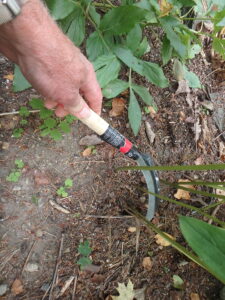
This harvest sickle will slice through stems quickly and is easily rotated
Cutting back the flower gardens is hard work and time consuming if you have extensive flower beds as I do. Many gardeners use their hand pruners and clip away, stem by stem. Not me. That is very hard on your paws. I like to use a curved serrated knife or small “harvest sickle” to do so. I grab a handful of stems with my left hand, then slice them off with my right. One motion, and no work for my fingers the way pruners would do.
You might also consider using a string trimmer to cut back big beds. I’ve done it, but don’t usually do so. It’s fast, but less precise. And I like to leave some flower stalks standing, things with seed for winter birds like chickadees and finches. I leave black-eyed Susans, purple cone flowers, sunflowers and anything else that looks tasty from a bird’s eye view.
The most radical way of cutting back flower beds is to use a lawnmower. I have one long, wide bed that is full of aster, Joe-Pye weed, goldenrod, giant foam flower and turtle head. In late fall I used to put the blade of my riding lawnmower up as high as possible and ride over it, mowing it all down. Now I no longer have a riding mower, and I doubt my battery mower would chomp through it. I will have to use the string trimmer, I guess. It’s a bed about 75 feet by 10 feet, so a motorized tool helps.
If you have dahlias and other tropicals growing in the ground and want to save the tubers for next year, only dig them up after a frost or two. Bring them into the basement or barn after you have shaken off most of the soil. I don’t wash the tubers, as a little soil will help keep them from drying out too much.
I store my dahlia tubers in a cold basement that doesn’t freeze. I put them in a box or tub with some sphagnum moss that is lightly moistened, and spray some moisture on in February. You can also store them in a plastic bag with holes punched in it and some bedding sold for gerbils in it, lightly moistened.
I love winter, but I’m always sad the morning after the first hard frost. Most of my annuals will have fallen, like wounded soldiers. But I also know that at my age, a season of rest from the garden will be good, too.
Putting the Garden to Bed
Posted on Tuesday, September 15, 2020 · Leave a Comment
Big yellow school buses are on the road again…or at least a few of them. Tree leaves in the swamps are turning red. Frost and cold weather are sneaking up on us. This year I resolve to get my garden put to bed early so that I am not wearing gloves and long johns as I cut back the daylilies and other perennials on cold, wet fall days. Here is what I am doing now – or will soon.
First on my list is the need to sow some grass seed. I have places where my lawn was killed when a torrential downpour dumped sand from my road onto the lawn. Fall is a better time to sow seed than the spring because the ground is warmer, and it will germinate quickly. In the spring, seed can rot during cold, wet weather.
I will spread some topsoil or compost to improve the soil, then mix it in with a short-tined rake. After spreading seed, I will cover it with a layer of straw. That will help to keep the soil and seeds from drying out, though I will water occasionally if the soil gets dry.
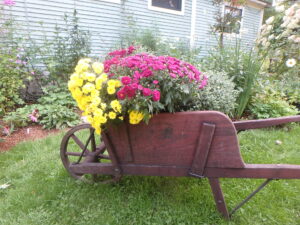
Chrysanthemums add color in the fall
Chrysanthemums are for sale now at farm stands, and I purchased a few pots of them to brighten up the front yard. I treat them as annuals, even though some of them are perennial. But the growers cut back the plants as they grow, causing them to branch out and produce hundreds of blossoms on bigger plants. If I let them over-winter, the plants would have some flowers, but never so many as what the professionals produce. It’s worth it to me to buy a few each fall.
Mums in pots tend to dry out quickly, so I have been soaking mine in my birdbath. That way the pots suck up water, getting it down deep. I could actually plant my mums in the ground, but I like them in pots on the front steps or in my wooden wheelbarrow. They need water every few days.
This is also the time of year when I move shrubs. I recently moved a Diervilla, one called ‘Kodiak’. It was given to me years ago, and it was crowded in between a crab apple tree and a red-veined Enkianthus. I decided it needed more space to grow, and I wanted to expose a stone wall behind it. So I dug it up.
This shrub is about 3 feet tall and wide, and had been in the ground more than 5 years. I used a shovel called a drain spade: a spade with a long, narrow blade. I pushed it into the ground at a 45-degree angle in 4 places around the bush. Each time I pushed the shovel handle down to lift the shrub slightly. Then, when I’d gone all around it, I got the spade under the middle of the plant, pushed down hard, and popped it right out.
I tugged on the plant, and pulled it loose, roots and all. Some were cut by my shovel, others not. I moved it to its new home, covered the roots and watered well. A week later it looks fine.
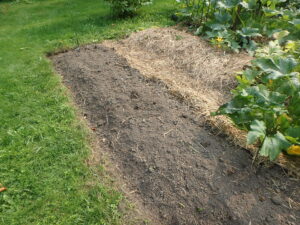
Never leave the soil bare. Cover with mulch to keep out wind blow seeds
The vegetable garden is winding down, and as each crop is harvested, I weed the row and apply mulch as needed it to keep wind-blown seeds from finding a home. My favorite mulch consists of chopped fall leaves: I run over leaves on the lawn with my lawnmower to chop them, and rake them onto a tarp which I drag down to the vegetable garden. It’s too early for leaves, so I’m using straw for now.
When cleaning up the vegetable garden it’s important to keep diseased plants separate from healthy ones (which go on the compost pile). I generally have a location for noxious weeds and diseased plants and do not use that material after it breaks down, or not for many years. It takes a pretty high temperature to kill weed seeds and fungal diseases, and I don’t want to chance getting either one back in following years.
I tend to get a little lackadaisical about the perennial flower gardens late in the season. Weeds and grasses have a way of showing up there, and by pulling them now, the work will be less in the spring. Cindy and I have done a pretty good job of mulching the flower gardens this year using a ground hemlock bark mulch, though some weeds push on through. This is a good time to get rid of those rascals.
Some gardeners cut back all flowers in the fall, others in the spring. Me? I cut back some, but like to leave some tall perennials with sturdy stems to stand proud above the winter snows. Birds enjoy their seeds. And some beneficial insects need places to lay their eggs, or to use as shelter. On the other hand, there is a lot to do in the spring, and cleaning up the flower beds now reduces the work later on.

This harvest sickle will slice through stems quickly and easily
Cutting back perennials with a pair of pruning shears is very tedious work. I prefer to use a serrated harvest sickle that allows me to slice through a handful of stalks in one quick motion. I have one that costs under $10 (a Barnet model BLK 730) and is available from OESCOINC.com, or by calling them at 800-634-5557. Just wear gloves when you use it – it’s very sharp.
This is also a good time to divide perennials to make more plants. Peonies, for example, are best divided and moved in late September to mid-October. Dig up daylilies, phlox or asters now the way you would a shrub, and then use a small saw or root knife to divide it into two or more new plants. Most plants like being divided – assuming you give them some compost and a little fertilizer.
Putting the garden to bed can be an enjoyable time – so long as you give yourself enough time to do it in small chunks. So get to work before it gets too cold to enjoy yourself.
Henry can be reached at P.O. Box 364, Cornish Flat, NH 03746 or by email at
henry.homeyer@comcast.net. He is a lifelong organic gardener and the author of 4 gardening books.
Putting the Garden to Bed
Posted on Tuesday, September 26, 2017 · Leave a Comment
Early autumn is a great time to work in the garden, and it’s not too early to start putting your garden to bed. I can work early in the morning without layers of wool, and my hands don’t need gloves to stay warm. Too often we gardeners wait until later, when frost is on the garden, to clean up. Start now, do a little each day, and the job will not be onerous.
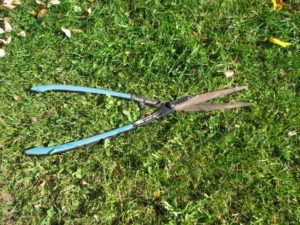
Hedge shears
Start by removing anything that is ugly. Your bleeding hearts (Dicentra spectablilis) has foliage that is yellow and has collapsed. Cut it out! Peonies may have dark blotches on the leaves – a potential sign of a fungal disease called botrytis – and should be removed.
Anything that looks like it is diseased should not go in the compost pile, but in the household trash or on a burn pile for winter. Be sure to cut right to the ground when removing foliage. Yes, you have to bend down a little lower, but the close to the ground, the better. That way you will be more likely to remove any diseased portions, and it will look better in the spring.
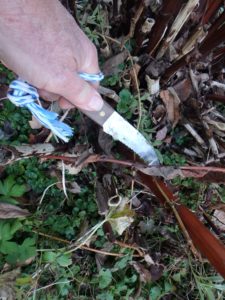
Serrated knife is good for cutting down flower stems
I know many gardeners like hand pruners to remove foliage, but I find that a bit tedious. I like a serrated knife. I hold a handful of tops, and with one swipe of my knife I cut through it all. The same group of stems might take a dozen snips. I’m all for speed and efficiency when working in the garden.
Other techniques? Hedge shears will make quick work of a big clump of iris leaves. But make sure they are sharp. Modern electric hedge clippers work, too, but I have been known to cut off the cord. Be sure to plug into one of those special outlets with reset buttons (GFCI) if you using electric hedge clippers – they’ll save you from getting electrocuted!
I have one 50 foot bed that is 8 to 10 feet wide. I call it my Darwin bed, as plants compete for space. No weeding. It’s full of tall plants like Joe Pye weed, turtlehead, phlox and more (including goldenrod for the pollinators). In late October, but before snow, I will run over the entire bed with a riding lawn mower, blade all the way up, engine racing at full throttle. It works!
You may wish to leave some flowers for the birds. Nice seed pods on purple cone flowers and black-eyed Susans will please the finches in winter, and look great above a thin layer of snow. Decorative grasses will sway in the winter wind, and look good for at least a month or two. You can always clean them up in the spring, or during a winter thaw if so inclined (and wearing wool).
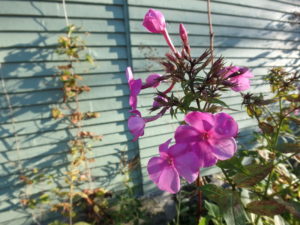
Phlox in November
As you cut back your perennials you will notice some volunteer plants. Phlox is forever planting itself around my garden, as is great blue lobelia and (dis-) obedient plant. It is natural to say, “Oh, how nice, the phlox is spreading.” But do I really want more phlox? NO, if I did want more, I would have planted more. I’d really like a new color, not more of the same. So I’ll dig it up and put it at the end of the driveway in a throwaway plastic pot. “FREE” will stop traffic.
As you cut back, weed! That will require different body motions – and fewer aches and pains. You probably already know some weeds by name, and by root. Some are perennials or biennials with deep tap roots. Others have lateral roots with nodes that send up more weeds. Annual weeds pull up with little effort and have small roots – but thousands of seeds. Try not to shake out seeds from weeds that have bloomed and set seeds. They will be back to annoy you for years to come.
I bring 2 tools with me for weeding: a garden fork and a CobraHead weeder. The fork is great for deep-rooted weeds. I plunge it in or step on it to force it into hard soil, then tip it back, loosening the soil. The weed, along with the deep root, will come right out, particularly if the soil is moist.
The CobraHead weeder has a single curved tine with a widened tip. It has become an essential tool for me; it’s like a curved finger. I use it to get under a weed. It allows me to lift and loosen soil beneath a weed while I tug on the top. If there are lateral roots, I tease them out, tugging and loosening until I have the entire darn thing.
Nothing beats crawling on your hands and knees for finding weeds. You are at their level. But if it’s hard for you to get back up, maybe you’d like to sit on something, particularly if the soil is cold and wet. I sometimes use a 5-gallon pail, but have seen some nice kneeling seats designed for gardeners, and have heard nice things about them. But to each her own.
Mulching? That can be the last step of fall clean up. Finely ground bark mulch or chipped leaves can be good for keeping down weeds, but don’t use too much. And try to keep it back from the crown, or center growing area of the plant. You can ruin peony’s ability to bloom by covering it with 3 inches of bark mulch. And avoid buying bagged mulch that is “color enhanced”. It has chemicals in it.
Me? I like flower gardens that have big clumps of perennials and lots of groundcover plants to cover bare spaces. That’s what Mother Nature does. I don’t like big swaths of bark mulch, though I use some in newer beds.
So go get to work on a nice day. It will save you time in the Spring.
Read Henry’s blog posts at https://dailyuv.com/gardeningguy You may e-mail him at henry.homeyer@comcast.net.
Putting the Garden to Bed
Posted on Monday, November 7, 2016 · Leave a Comment
Each year about now I suddenly realize that I should have already finished putting my garden to bed. This year I had a good excuse: I’d gone to France to hike, and was away for 3 weeks. But in other years my excuse has been the weather, or finishing a book that I was writing. You get it … I can be a bit of a procrastinator. Most of us are. But if you haven’t finished cleaning up your gardens yet, now is the time to get to work. Winter is just around the corner.
First, and most important to me, is to clean up the vegetable garden and get rid of weeds. I mulch heavily with newspapers and mulch hay, but there are still weeds present. Last week I raked off any newspapers my hungry earthworms had not eaten, and the rotting mulch hay on top. Then I dug out my weeds and lugged them away. Because of the mulch, weeding was not too time-consuming.
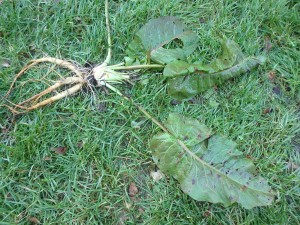
Dock
I did have some deep rooted weeds, mainly dock (Rumex spp.). The roots of this weed can easily go a foot deep in the first year. So I couldn’t just pull them, even with my favorite weeding tool in hand, the CobraHead weeder. They are a job for a garden fork. I push down on it with my foot, and the four tines go down a foot in the soil. I pull back, and it loosens the soil and lifts the roots a little. Then I am able to tug it out, roots and all. Later I will cover the beds with chopped leaves.
A buddy of mine called recently from Maine asking what to do with the leaves in their flower beds. Should he rake them out now or in the spring? I know a gardener who rakes all her leaves out onto the lawn, runs them over with the lawn mower, bags them up while nice and dry, and then stores them on the barn until spring. She cuts all her perennials down in the fall, too. Then, once the plants have all appeared in the spring, she mulches with the same leaves that were there in the fall.
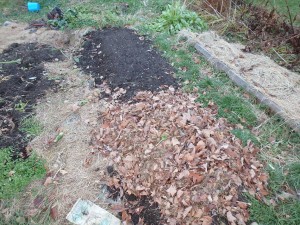
Leaves are a great mulch
That method works fine and the added organic matter from all those chopped leaves have built up her soil beautifully over the years. The chopped leaves hold in moisture and keep down weeds. But it’s a lot of work.
My approach is the Lazy-Boy way. I leave the leaves in place now – and in the spring, too, unless they are choking out small plants or covering something special. As a matter of aesthetics, if you don’t like the look of leaves, rake them up. Otherwise, leave them be and they will break down over time.
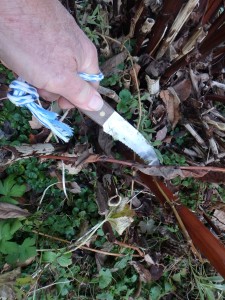
Root knife is good for cutting down flower stems
I will try to cut down most flowers before the snow flies. I leave some things with seeds for birds, sunflowers and black-eyed susans, for example. Instead of using hand pruners, I use a special serrated “root knife” that, unfortunately, is no longer commercially available. When I lose the last of my root knives, I’ll just use a steak knife – or find another manufacturer of the root knife, which has a nice curve to it. Why a knife? Cutting down hundreds of stems is tiring on the hands if using pruners.
You could also use a string trimmer or even a lawn mower to cut everything down. I have one long flower bed that I call my “Darwin bed”. It is full of tall flowers that can compete with the weeds – and each other. Asters, goldenrod, Joe-Pye weed, tall phlox, turtlehead and more compete for space. If a plant doesn’t survive, something else will fill up the space. In the fall I usually just run over it with my riding lawn mower, making it neat and tidy for a few minutes in the spring.
Another fall task involves improving the soil. I recently had my soil tested by Logan Labs (www.loganlabs.com). Their basic test gives a lot of information: pH, percentage of organic matter, mineral contents, trace mineral levels and more. As a member of the Bionutrient Food Association (http://bionurient.org), I was able to get recommended levels of minerals and trace minerals for top quality production, and what (and how much) to add. Of course, each state offers soil testing through their Cooperative Extension service.
My soil is excellent, but needs a little tweaking. Boron, for example, is a little low, as are my potassium levels. I will make some additions this fall so that the added minerals can be incorporated into the soil over the fall, winter and spring. Green sand, a bagged supplement, is a good source of potassium.
The key to any soil addition is to remember that if adding a little is good, adding more is NOT. Even useful additions to the soil need to be done in carefully measured quantities. I will mix the minerals I add to the soil with a measured amount of compost, making it easier to distribute small quantities over my garden. So, for example, I need to add half a pound of calcium borate per 1,000 square feet of garden space – or about a pound for my 1,700 feet of vegetable garden. By mixing it in with compost I can distribute that better.
My blueberries – and yours – need a little agricultural sulfur added every year to keep the soil acidity good for them. Blueberries produce much better if the soil is very acidic – around 4.5 to 5.0. My recent soil test showed that in my garden beds the soil is 6.6, or just slightly acidic and perfect for vegetables. So I add sulfur each year to the blueberries to keep it acidic enough to produce well.
If I have the time (and the right weather) I will also weed around my blueberry bushes before adding sulfur. Blueberries have fibrous roots near the surface, so I’ll need to be careful. After weeding and adding sulfur I will mulch heavily with chipped branches to keep down the weeds.
There is lots more to do, of course, so I better stop writing and head outside to the garden while the weather is nice.
Read Henry’s garden blog at https://dailyuv.com/gardeningguy. He is the author of 4 gardening books. His web site is www.Gardening -Guy.com.
Just last week that I was planting tomato and pepper seedlings – or so it seems. But now the big yellow buses are out there each morning, delivering the next generation of gardeners to school, and there is a definite nip to the air when I go to get my newspaper out of the box in the morning. Where has the summer gone? It’s time to start thinking about putting the garden to bed.
This is the time of year that weeds take advantage of us. Most of us tend to be lackadaisical about weeds now that our vegetables have produced, our flowers have bloomed, and our attention has turned elsewhere (school, football, presidential debates). But if you want to reduce your work next year, pay attention to those weeds that have snuck into the garden: they are producing seeds that will lie in wait for the spring, ready to grow before we get the good plants established.
I hereby resolve to spend a minimum of 20 minutes every day weeding for the rest of September. If I do that, I shall save myself much aggravation next spring. Here are a few things to consider when you weed. First, weed when the soil is moist – you are much more likely to get out the entire root system. That is very important for perennials weeds like dandelions or witch grass because a scrap of their roots will regenerate new weeds.
Annual weeds pull more easily, and it’s less important to get the entire root. They reproduce by seed, and often produce hundreds, even thousands of seeds per plant – and those seeds can stay viable for years. When weeding things loaded with seeds, be careful not to shake off the seeds when you pull the weeds. It means that you can’t shake off all the topsoil that comes out with the roots, but I’d rather avoid dumping seeds into my garden soil- even if I lose some.
I also try to place seed-bearing weeds in a compost pile that I will not use any time soon. In fact, I have compost piles where I dumped problem weeds decades ago. I let it turn into soil and use it for fill dirt– but not in my vegetable garden. After all, I heard that King Tut’s tomb had weed seeds that were still able to germinate, though that may be just a myth.
I am also conscious of erosion when weeding and removing annual plants in the fall. I think it’s better to cut off the stem of big zinnias, for example, than yank them now. That way I am not opening up the soil, making it vulnerable to erosion or providing a nice resting spot for air-borne weed seeds. Many weed seeds are tiny and can blow in from your lazy next-door neighbor’s garden. I can always dig out roots in the spring when I plant something else, and they may decay and add some organic matter to the soil in the meantime.
In the vegetable garden it is important to get rid of diseased or insect-infested plants. You shouldn’t put them in the compost, either. Put them on the burn pile if you’ll be burning brush this winter, in the household trash, or in a pile far from the vegetable garden. This will help to minimize the recurrence of problems. That goes for moldy phlox or other flowers that get diseases, too.
If you have an asparagus patch, look to see if your plant are loaded with those little “berries”, their seeds. If you see seeds, cut down the stems before winter. Some of those seeds will settle in and start more asparagus plants, but you really don’t want more plants – they will fight for moisture and minerals just as weeds do. Most asparagus plants sold now are in the “Jersey” series and are all male, so they bloom but do not produce seeds. But one of the 25 plants I put in this year was a female, so take a look at yours now and cut down any with berries. And for best production, get out any weeds this fall.
I like to prepare my vegetable beds in the fall. After weeding them, I re-shape my mounded raised beds and add some compost or aged manure. Then I cover them with chopped fall leaves and grass that I rake up after mowing. This stuff does not blow away as you might imagine – one good rain storm and it settles down for a long winter’s nap.
Fall is a good time to spread some limestone on the lawn, or to your vegetable and flower gardens if your soil pH is acidic. Most things grow best at a relatively neutral pH, say 6.2 to 6.8, but what with acid rain, many of us have soil that is pretty acidic. This is a good time to get a soil test done and make adjustments as needed. It takes time to adjust soil pH, so working on that now will make the soil better next spring.
There is so much to do in the garden, week after week. It’s important not to just throw up your hands and say, “I’m done!” Yes, fall is here. But don’t stop gardening – everything you do now will help make next year’s garden even better.















